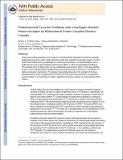| dc.contributor.author | Yang, Jay L. | |
| dc.contributor.author | Nocera, Daniel G. | |
| dc.contributor.author | Pizano, Arturo Alejandro | |
| dc.date.accessioned | 2013-11-25T19:50:21Z | |
| dc.date.available | 2013-11-25T19:50:21Z | |
| dc.date.issued | 2012-05 | |
| dc.date.submitted | 2012-01 | |
| dc.identifier.issn | 2041-6520 | |
| dc.identifier.issn | 2041-6539 | |
| dc.identifier.uri | http://hdl.handle.net/1721.1/82588 | |
| dc.description.abstract | Amino acid radical generation and transport are fundamentally important to numerous essential biological processes to which small molecule models lend valuable mechanistic insights. Pyridyl-amino acid-methyl esters are appended to a rhenium(I) tricarbonyl 1,10-phenanthroline core to yield rhenium–amino acid complexes with tyrosine ([Re]–Y–OH) and phenylalanine ([Re]–F). The emission from the [Re] center is more significantly quenched for [Re]–Y–OH upon addition of base. Time-resolved studies establish that excited-state quenching occurs by a combination of static and dynamic mechanisms. The degree of quenching depends on the strength of the base, consistent with a proton-coupled electron transfer (PCET) quenching mechanism. Comparative studies of [Re]–Y–OH and [Re]–F enable a detailed mechanistic analysis of a bidirectional PCET process. | en_US |
| dc.description.sponsorship | National Institutes of Health (U.S.) (GM47274) | en_US |
| dc.language.iso | en_US | |
| dc.publisher | Royal Society of Chemistry, The | en_US |
| dc.relation.isversionof | http://dx.doi.org/10.1039/c2sc20113e | en_US |
| dc.rights | Creative Commons Attribution-Noncommercial-Share Alike 3.0 | en_US |
| dc.rights.uri | http://creativecommons.org/licenses/by-nc-sa/3.0/ | en_US |
| dc.source | PMC | en_US |
| dc.title | Photochemical tyrosine oxidation with a hydrogen-bonded proton acceptor by bidirectional proton-coupled electron transfer | en_US |
| dc.type | Article | en_US |
| dc.identifier.citation | Pizano, Arturo A., Jay L. Yang, and Daniel G. Nocera. “Photochemical tyrosine oxidation with a hydrogen-bonded proton acceptor by bidirectional proton-coupled electron transfer.” Chemical Science 3, no. 8 (2012): 2457. | en_US |
| dc.contributor.department | Massachusetts Institute of Technology. Department of Chemistry | en_US |
| dc.contributor.mitauthor | Pizano, Arturo Alejandro | en_US |
| dc.contributor.mitauthor | Yang, Jay L. | en_US |
| dc.contributor.mitauthor | Nocera, Daniel G. | en_US |
| dc.relation.journal | Chemical Science | en_US |
| dc.eprint.version | Author's final manuscript | en_US |
| dc.type.uri | http://purl.org/eprint/type/JournalArticle | en_US |
| eprint.status | http://purl.org/eprint/status/PeerReviewed | en_US |
| dspace.orderedauthors | Pizano, Arturo A.; Yang, Jay L.; Nocera, Daniel G. | en_US |
| dc.identifier.orcid | https://orcid.org/0000-0002-4507-1115 | |
| mit.license | OPEN_ACCESS_POLICY | en_US |
| mit.metadata.status | Complete | |
